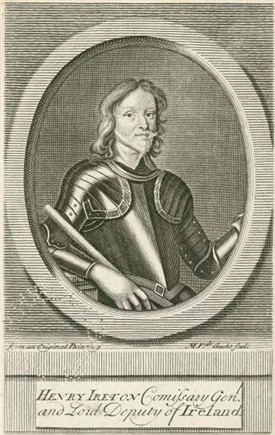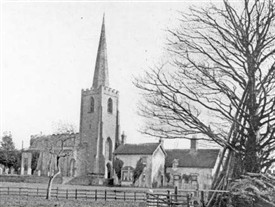Henry Ireton of Attenborough

Henry Ireton (1611-1651)
Pictured at the time he was Lord deputy of Ireland in 1650

Attenborough Chuch with Henry Ireton's birthplace visible right
www.picturethepast.org.uk
Civil War general and son-in-law to Oliver Cromwell
Born November 1611 in Notts; Died November 1651 in Ireland; Body exhumed and gibbeted at Tyburn, January 1661
Henry Ireton was born in a house to the west of Attenborough church. During the time of the English Civil Wars (1642 - 1649) he became a famous Parliamentary general who went on to marry a daughter of Oliver Cromwell.
The Attenborough parish registers record his baptism under the date 10th November 1611 (and in 1615 there appears that of his brother, John, who became Lord Mayor of London).
At the age of 15 Henry Ireton attended Trinity College Oxford, graduating Bachelor of Arts on 10th June 1629. Thereafter he read law in the Middle Temple, but was not called to the Bar.
"A Mirror of Godliness"
One account of Ireton's character** described him as 'a distinguished scholar [who] having early imbibed the prevalent sentiments of the Puritans,.... was ranked among the disaffected to a dissolute court as a "mirror of godliness" and as a shining light to guide his friends in the ways of righteousness'
Little wonder, therefore, that when Civil War broke out in 1642 he immediately raised a body of men from estate workers (said to have been forced from their homes by men loyal to king Charles) to fight on the Parliamentarian side.
Ireton joined the army of the Earl of Essex, being subsequently appointed Major in Colonel Thornhaugh's Nottinghamshire Regiment of Horse.
With that portion of the army he marched in 1643 to relieve the town of Gainsborough where he fought under the immediate command of Oliver Cromwell.
A son-in-law to Oliver Cromwell
A strong friendship grew up between the two men, with Ireton - the out-and-out republican - transferring into Cromwell's regiment. Ireton subsequently married Cromwell's eldest daughter, Bridget, and almost immediately thereafter was promoted to Colonel.
He was further promoted to Commissionary-general of Cavalry in 1645 when the army was being remodelled.
Cromwell rides to the rescue as Ireton is wounded in face and thigh
At the Battle of Naseby, Ireton commanded the left wing of the Parliamentarian army. He fought with considerabe personal bravery, being run through the thigh with a pike, wounded in the face by a halberd, and had his horse shot from under him before being finally taken prisoner.
Cromwell, however, personally galloped to his rescue, his corps of men causing sufficient confusion in the Cavalier ranks as to allow Ireton to escape.
Ireton took part in all the major victories of the Parliamentarian forces - Naseby, Bristol, Marston Moor - and in 1646 was returned as MP for Appleby.
Peace, Piety..... and Regicide
In a letter to his daughter Bridget, Cromwell referred to Ireton in the following terms
"That which is best worthy of love in thy husband is that of the image of Christ, which he bears; look on that and love it best".
Ireton was appointed elected a commissioner to the High Court of Justice before which tribunal Charles I was tried, found guilty, and condemned to death. Ireton was one of the 59 who signed the king's death warrant.
A move to Ireland
After the death of Charles I in 1649, Ireton received the rank of Major-general and proceeded to Ireland to quell disturbances.
He took on the office of President of Munster in 1650, and the same year, following Cromwell's departure for England, assumed the role of Lord Deputy of Ireland.
Iteron died on 26th November 1651 at the siege of Limerick, although not from the wounds of battle, but, it is said, of a fever brought on by excessive fatigue.
Such was the regard of Cromwell, that he caused Ireton's body to be lain in state for a considerable time, before, with much pageantry, it was brought for burial in the Henry VII chapel at Westminster Abbey.
Not allowed to rest in peace
Following the Restoration of the monarchy in 1660, and having been found posthumously guilty of regicide, Ireton's coffin was removed from its resting place 'amongst the kings' in Westminster Abbey (January 1661), and dragged ignominiously on a hurdle through the city streets.
At Tyburn his body was taken from the coffin and hung on a gibbet 'from sun-rise to sun-set', the head afterwards being severed from the body and displayed upon a pole. (His other remains were deposited in a deep grave beneath the gallows).
** Anon. The Nottingham & Derby Railway Companion (Nottingham; R.Allen, 1839) pp.18-19.